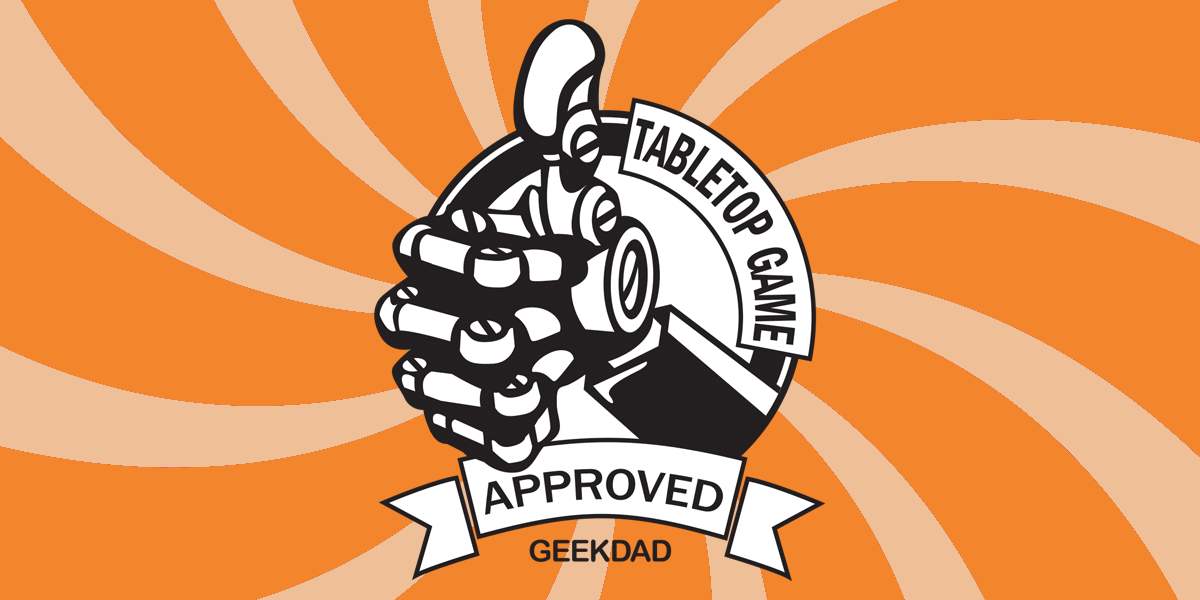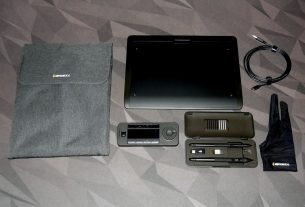Can’t get enough of pandemics? Take a step back in time to Black Death infected Bristol, England, for some back-stabbing fun trying to escape the city. Arsenic and leeches as remedies? Take two and hold on for the cart ride of your life.
What Is Bristol 1350?
Bristol 1350 is a dice-rolling deduction game for up to 9 players, ages 13 and up. It usually takes about 20 to 40 minutes to play. It is a very interesting mix of social deduction, cooperative teamwork, and making sure you win at any cost. Bristol 1350 is designed by Travis Hancock and published by Facade Games. The illustrations are by Sarah Keele and graphic design by Holly Hancock.
The game was introduced via a Kickstarter in May 2020, and it was delivered in March 2021. I bought the deluxe edition of the game from Kickstarter and received the game with the upgraded components and Alms expansion. It is the 4th game in the Dark Cities Series and fits right in thematically with the other games. The overall design of the game is a book, and as such, it would look great on any bookcase.
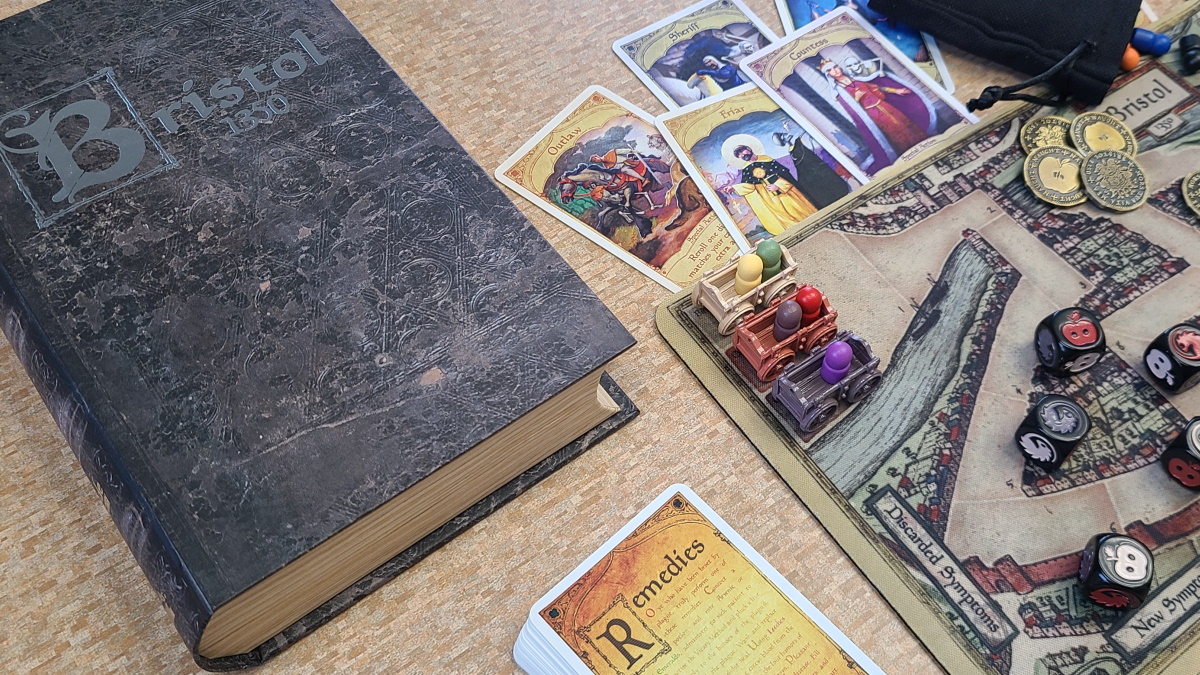
You can purchase the game at Amazon, or directly from the Facade Games website where the list price is $24.99.
Bristol 1350 Components
Here’s what is included in the box:
- 1 neoprene game map
- 9 wooden pawns
- 3 resin carts
- 6 custom dice featuring rats and apples
- 1 drawstring cloth bag
- 9 character cards
- 32 symptom cards
- 27 remedy cards
If you have the Deluxe Edition, it also includes some component upgrades and additional components to play the Alms Expansion:
- 3 metal carts instead of resin carts
- 6 metal coins
- 6 additional cards
- 3 mini art prints by Sarah Keele
The components used in Bristol 1350 really do help make the game. The theme is very well carried out with the pieces, and the relative simplicity of them helps keep the focus on the game itself. The carts are meant to represent wooden carts that you are riding in to escape Bristol, England, and the Black Death spreading there. The different colors represent birch, cedar, and oak wood. I have the deluxe edition of Bristol 1350 and the carts are metal. The normal edition includes resin carts in the same colors, and from the pictures I have seen, they also look very well made. The pawns are simple wooden pieces painted in distinct colors.
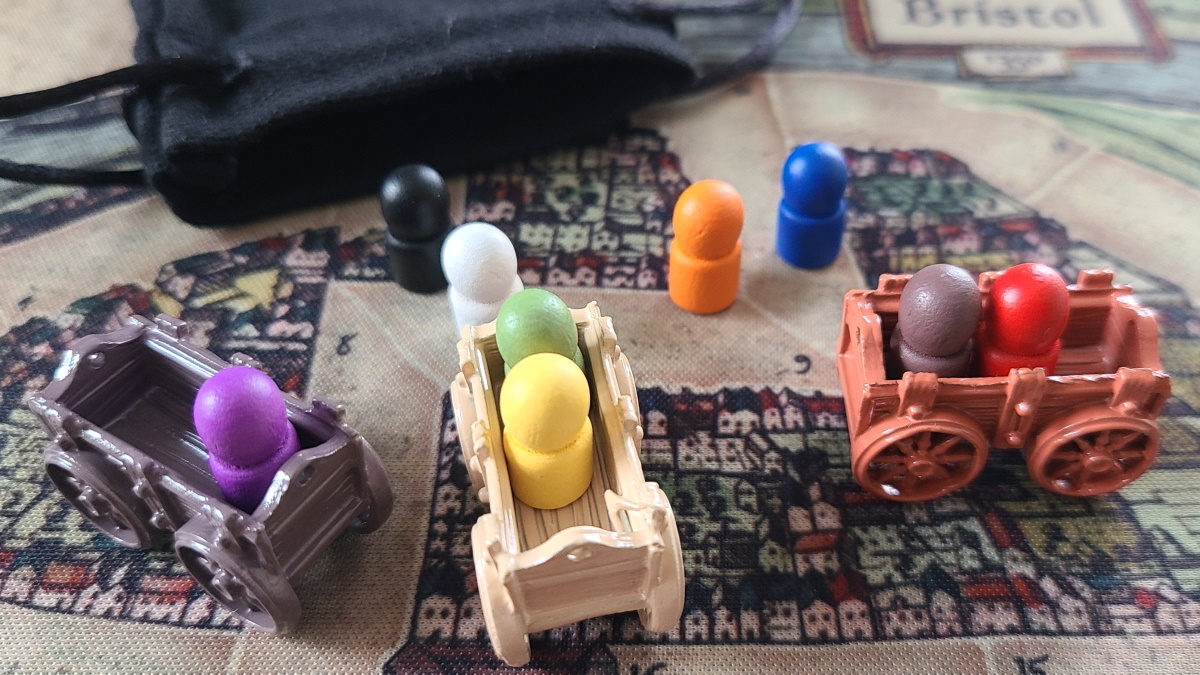
The colors of the pawns correspond to the nine character cards in the game. One thing my group had a slight problem with was identifying the color of the character card and which pawn it matched up with. Here is a hint…the barmaid matches the white pawn. It may be a minor issue, but this was one area of the game where consistency felt missed. The art, on the other hand, really brings out the flavor of the game, and our group spent a lot of time just admiring the different characters.

One nice touch that Facade Games brought to Bristol 1350 is multiple ways of extending and changing the game to enhance replayability. The character cards, for instance, are double-sided. They suggest using the side showing the turn actions if you have any new people playing the game, and the side showing the character special actions if you want more challenge and variety.
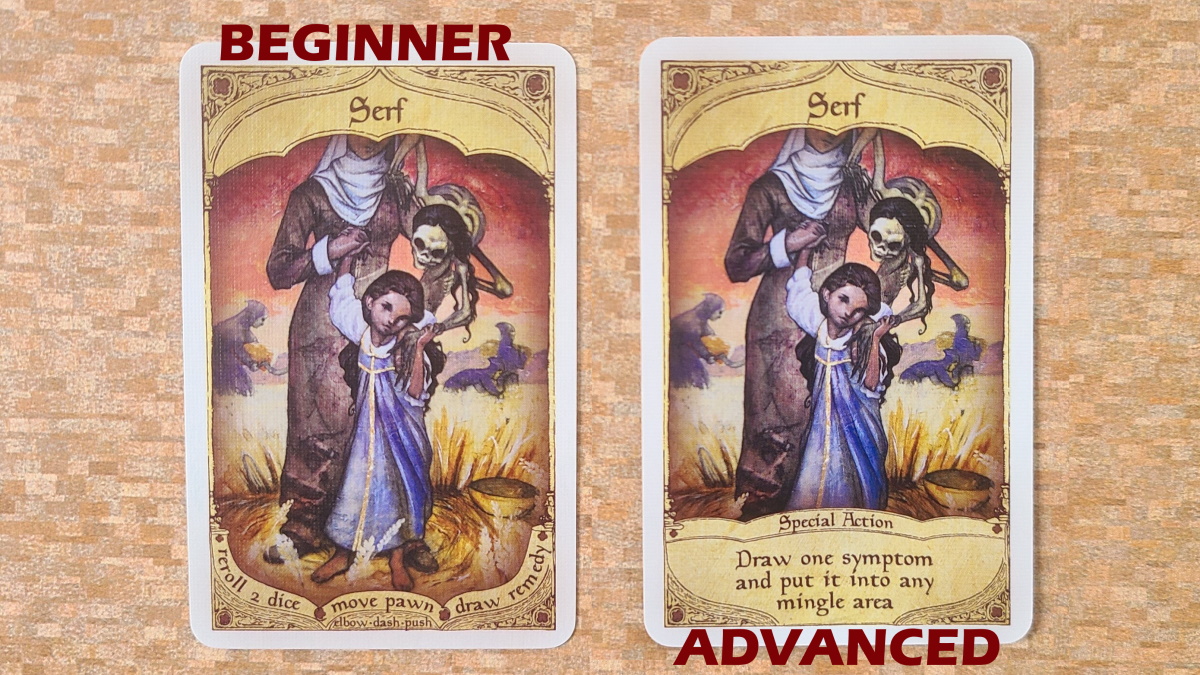
The dice in the game are very well made, and have a nice heft to them, with rounded corners. They have images of rats and apples, matching the color of the birch, cedar, and oak carts. The dice are rolled at the beginning of the turn and can be rerolled throughout the turn to alter the outcome and moves that occur at the end of the turn.

The neoprene game board is a refreshing take on a standard board. It rolls up for easy storage, and it adds a higher quality feel to the whole game. The board itself is printed with a map of medieval Bristol with a road winding through the city that your carts must make their way along. There are also printed areas on the board showing where you can put symptom cards, and areas for cards for the mingle phase of each cart.

The symptom cards are used to infect players with the bubonic plague as the game goes on. At the beginning of the game, you will be healthy. As the game goes on, there will be several opportunities, called “mingles”, for you to swap symptom cards with other players in your cart. After these phases, your symptom cards may add to six or greater. If they do, you are infected for the rest of the game. Playing counterpoint to the symptom cards are the remedy cards. These cards provide various actions you can take on your turn, adding depth to the strategies you have for ensuring you survive and the players in the other carts don’t fare so well.

How to Play Bristol 1350
Bristol 1350 is a difficult game to slot into one genre. There is the dice rolling aspect, trying to get the rolls you want. There is the deduction aspect, trying to determine who might already be sick. There is the cooperative aspect, trying to keep your cart healthy so you can escape the city and win. Throughout the game, healthy players will become sick, changing your goal from escaping the game healthy to making sure no one wins. The setup of the game is simple, allowing you to quickly jump in to this mad race to avoid the Black Death.
Place the game board on your play surface, and the three carts in their starting locations marked on the board. Each player chooses a character card, and the matching colored pawns are put in the bag to be drawn randomly. As they are pulled out of the bag, they are placed on the carts, front to back, in the manner described by the instructions.
Once you have the carts populated, you can then set up the deck and draw cards. Begin by removing all “buboes” (symptom cards worth four) from the symptom deck. Shuffle the remaining cards and deal two to each player. The goal is for all players to start with symptoms totaling five or less, so if any players ended up with both cards being “chills” (value of three), then take those cards back and deal two more to them. Now you put the “buboes” symptoms back in the deck and shuffle it. Place it face-down next to the “New Symptoms” label on the board. Shuffle the remedy cards and give each player a number specified in the setup table in the instructions. Place the remaining cards face-down next to the board as well, and you are ready to begin.
Each game round is started with someone rolling the dice. This roll sets the stage for the remainder of the turn because the status of those dice at the end of the round dictates how each cart moves. Your cart moves forward one space for each die showing your cart color, regardless of whether they are rats or apples. So what are you to do between that first roll and the fateful sound of those wheels turning? That is where the strategy and choices come in.
The player at the front of the cart in the lead is the one who plays first. On your turn, you choose one of three actions. You can reroll any two of the dice. There are several reasons you would choose this as your action. The most obvious is the more dice showing your cart color, the further your cart moves forward at the end of the round. Another reason we have not touched on yet is if two or more rats are showing for your cart, you will be forced to “mingle” at the end of the turn before your cart moves, which increases your chance for infection. Another reason you would reroll dice is to hamper the competing carts, causing them to fall behind on the road so you can pass through the exit gate first.
Another action you can take is drawing one remedy card. You are only allowed to have three remedy cards in your hand at any time, so you need to use these strategically. Let’s take a closer look at the remedies. There is arsenic, which locks two dice so they cannot be rerolled. You could play your arsenic card when you like the two apples in your cart color and you want to lock them. The Chicken remedy comes into play if you reroll dice on your turn, and aren’t happy with the result. Chicken allows you to continue to reroll those dice four more times to get the roll you want. Pomander lets you draw two additional symptom cards, then pick which two you want to keep, discarding the rest. This is great if you find yourself with cough and chills cards, and you want to lower your symptom score to stay healthy. Leeches let you draw two symptom cards to stack the mingle decks in your favor or against your opponent’s carts. You pick which symptom card will be placed in the mingle pile for use the next time that cart needs to mingle. Crushed emeralds let you take another pawn move action, which comes in handy as you claw your way to the front of the carts. Whip is the only symptom card you can play on another player’s turn, and it allows you to stop their movement if they are trying to move past you in a way you don’t want.
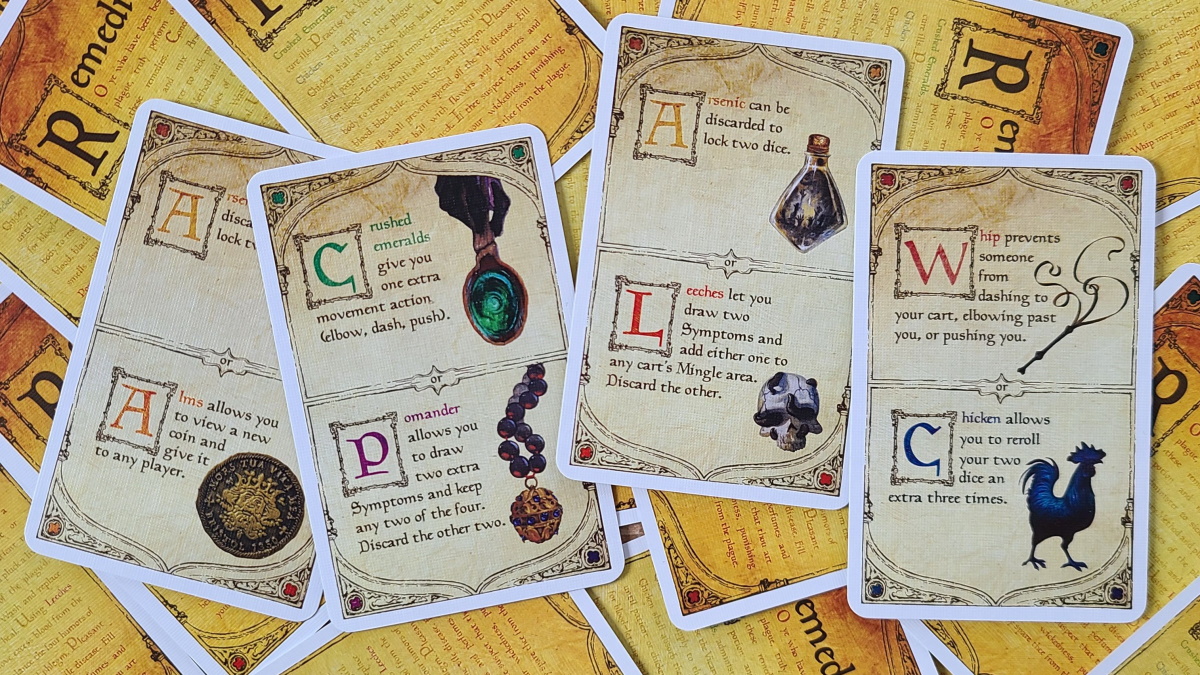
The final action you can take is moving your pawn, which can be done in one of three ways. You can “elbow” your way to the front of the other pawns in your cart. If you are at the front of your cart, you can “dash” to the cart in front of you. If that cart already has three pawns in it, the rear pawn in that cart gets bumped to the front of the cart you are leaving, essentially swapping places with you. The final move you can take is “pushing” your pawn or another pawn behind you on your cart off of the cart. The pushed pawn is placed as far back in the cart chain as possible, taking the furthest back spot. If there are no spots available, then that pawn is left behind, doomed to die of the Black Death. An interesting side note here…if you are pushed off and left behind, but you were healthy, you can reveal that fact and the person who pushed you dies of shame and also gets to sit out the rest of the game with you.
Once all players have taken their action, the carts then have the potential to “mingle” before moving forward. Mingling happens whenever two or more rats show up for a particular cart color. When you must mingle, all players on that cart place their symptom cards, face down, in the mingle area next to the board. One additional card is also placed in the mingle pile from the symptom deck, or a card might already be there from someone playing a Leeches remedy card. The mingled cards are then shuffled and two are dealt to each player in the cart, becoming their new symptom load. If you are unlucky enough to have your new symptoms add to six or more, you are now infected with the Black Death. Don’t tell the other players though, because now is your chance to infect them! Do note that once you become infected, you are infected for the rest of the game, even if your symptom total drops below six during a future mingle or due to a remedy card.
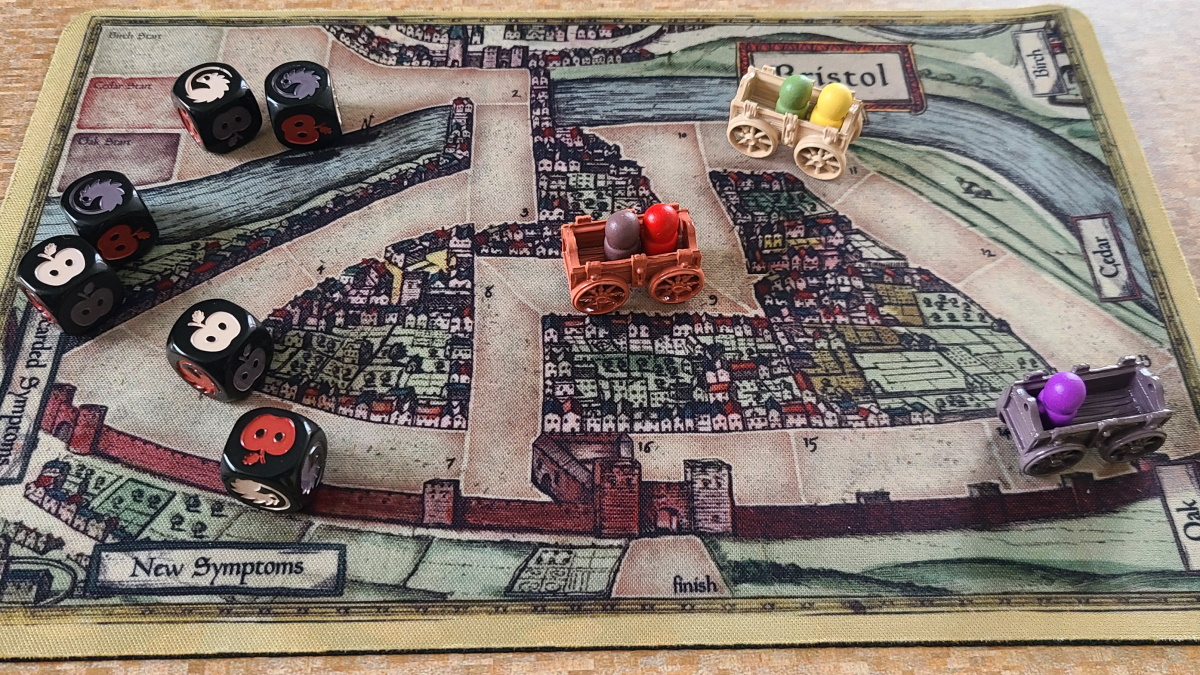
After all of the actions and mingling, the carts move forward the number of spaces equal to the number of dice in their color. Play continues in this fashion until the first cart crosses through the gate out of town, and it becomes time to reveal if they are all healthy, or if they brought an infected player with them.
Am I Sick? Are You Sick? Did I Win? Wait, Did You Infect Me?
Bristol 1350 can end in one of several ways. Let’s explore the case where one of the carts makes it out of Bristol. At that point, all of the passengers on that cart reveal their health status. As long as all of the passengers are healthy, then congratulations, you are the winners! If any one person is infected, then everyone on that cart loses. Yeah, that’s pretty harsh, but so was the Black Death.
Now the clock starts ticking, and the second and third carts have one additional round get through the gate out of town before it slams shut, trapping them and the passengers inside. If one of them does make it out, again, everyone on that cart needs to be healthy to win.
Finally, we come to the easiest win condition, which happens to be losing. If no one crosses through the gate out of town in a healthy state, then everyone who has the plague wins, if you can call that winning. So you see at some point, your strategy will switch from trying to stay healthy and get out of town, to infecting as many people as possible so you win because no healthy tokens made it out. The Black Death certainly wasn’t a time of fun and games, even if Bristol 1350 happens to be a fun game about the Black Death.
Addons and Extras for Bristol 1350
I got my copy of the deluxe edition of Bristol 1350 from Kickstarter. That deluxe edition included the metal carts, six additional cards, and six metal coins that comprise the “Alms” expansion. The Alms expansion brings a new element to the game with coins that can confer immunity or instant infection from the plague. These coins are taken by a player when they play an “Alms” remedy card, and they can choose to hold on to the coin or pass it to another player. Finally, three art prints from the illustrator, Sarah Keele, are included. The deluxe edition can still be purchased from Facade Games. Another addition you can find on their website are “Meepawns”, which allow you to replace the simple wooden pawns with customized meeples in the same colors.

Items that are not currently available include 9 additional characters cards that were an exclusive for the Kickstarter campaign, along with a silver foil card that acts as a first player marker and reference card. One fun item that was included in the campaign was a link to Next Level Board Gaming who put together a 3D printed board, painted and ready for Bristol 1350. All the information you need to do the same yourself is included at their site, for those folks with a lot more time and ambition than I have!

My Two Cents for Bristol 1350
Bristol 1350 is a very well-crafted game. It takes a similar theme to the other Dark Cities Series games and adds the unique twists of the race to leave the city and the cooperative and backstabbing aspects. It also keeps the higher player count, making this game a valuable addition to your collection. I found balancing the different choices very fun, and the group I played the game with all had a good time, laughing as the cart in the lead raced through the gates, only to find they brought an infected person along with them. The other carts were too far back to have any hope of clearing the gate before it closed within one turn, ensuring all of us died of the Black Death.
Bristol 1350 is GeekDad Approved!
One thing worth looking at is the concept of players ejected early in the game. Dead players, while out of the game, are still encouraged to participate in the propaganda and communication aspects of the game, as their goal is to help ensure no one makes it out alive. While this is a nice idea to push, you do still need to face that this is a game where dead players don’t have a lot to do. Luckily, the game doesn’t last all that long, so the periods of waiting dead players do aren’t nearly as bad as they can be in other games. And with the right conditions, they still can have fun.
The instruction manual has sections dedicated to strategies to think about and other ways to play the game, as well as background information on the setting of Bristol, and the Black Death itself. I appreciate that Facade Games has put forethought into ways to keep their game more replayable by offering what amount to “house rules” that people may want to use in future sessions.
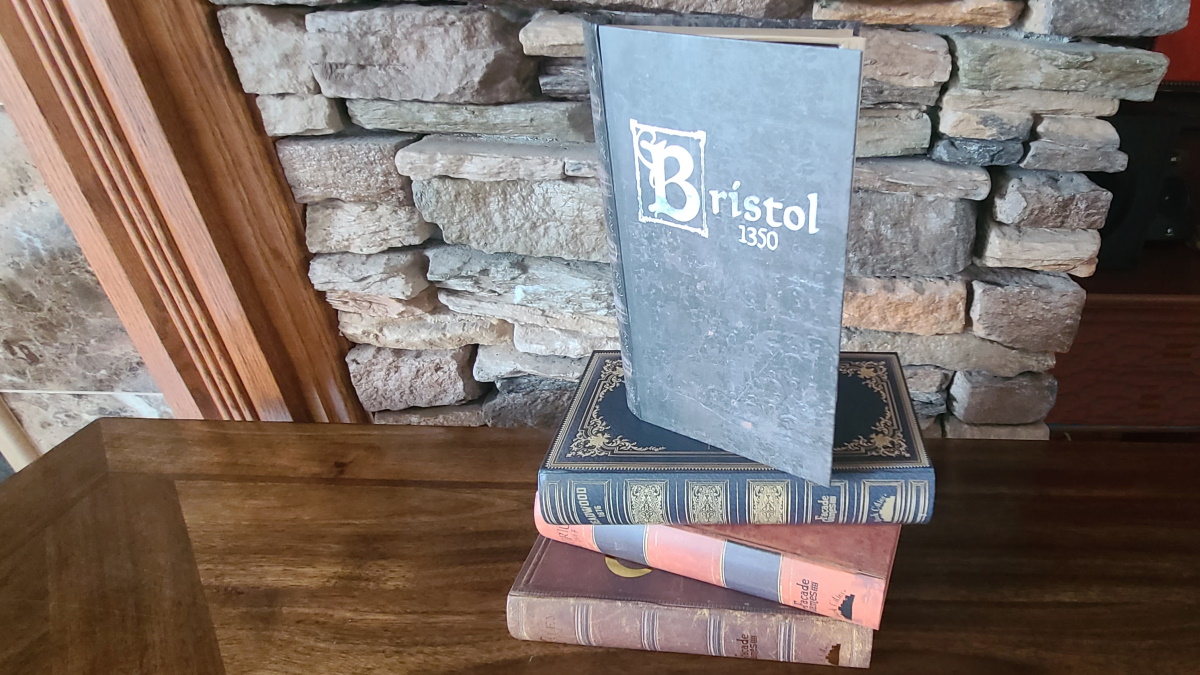
On the design side of things, I applaud Facade Games for doing something original with the bookshelf look of their games. This, combined with the terrific art and graphic design, makes the game something you can be proud to display. Overall, I found Bristol 1350 very playable and it has seen its turn at our table many times since we first played it, making it GeekDad Approved and worthy of a place on your bookshelf and game table!
Click here to see all our tabletop game reviews.
![]() To subscribe to GeekDad’s tabletop gaming coverage, please copy this link and add it to your RSS reader.
To subscribe to GeekDad’s tabletop gaming coverage, please copy this link and add it to your RSS reader.

